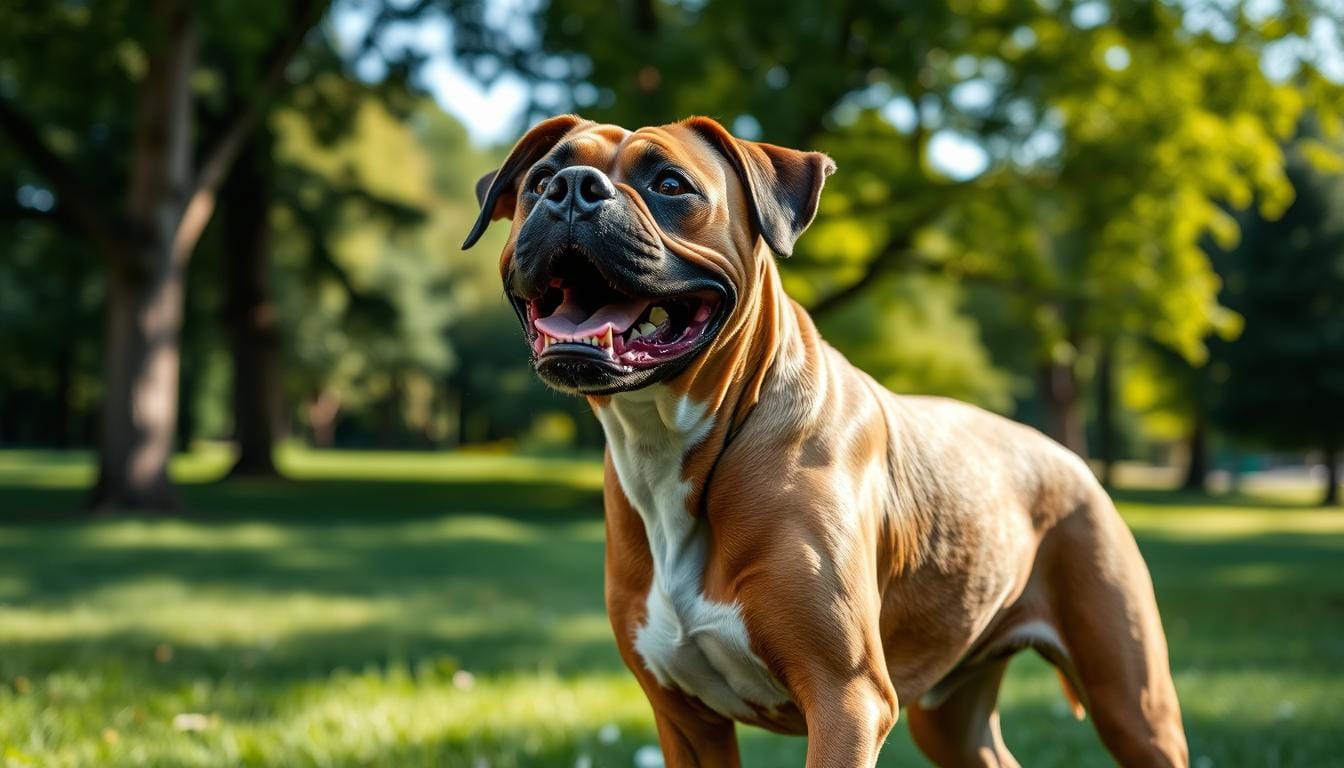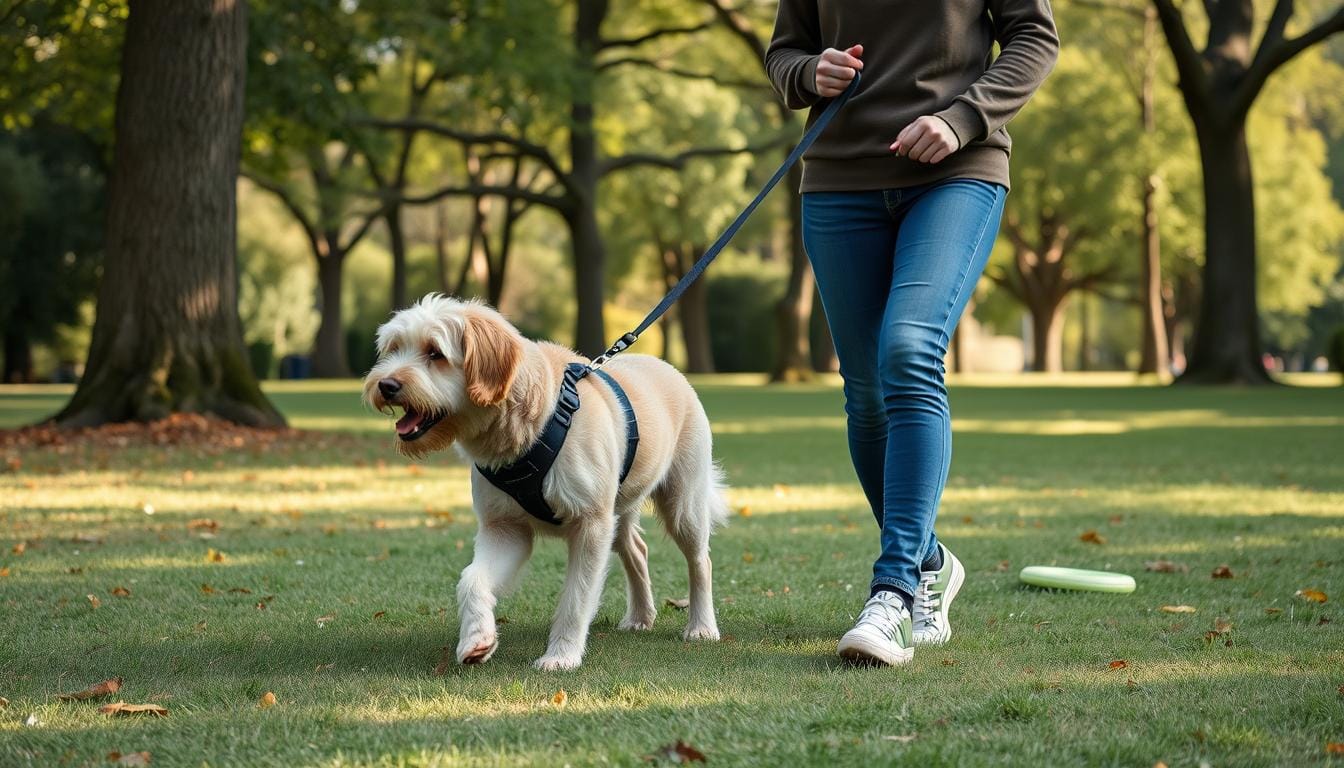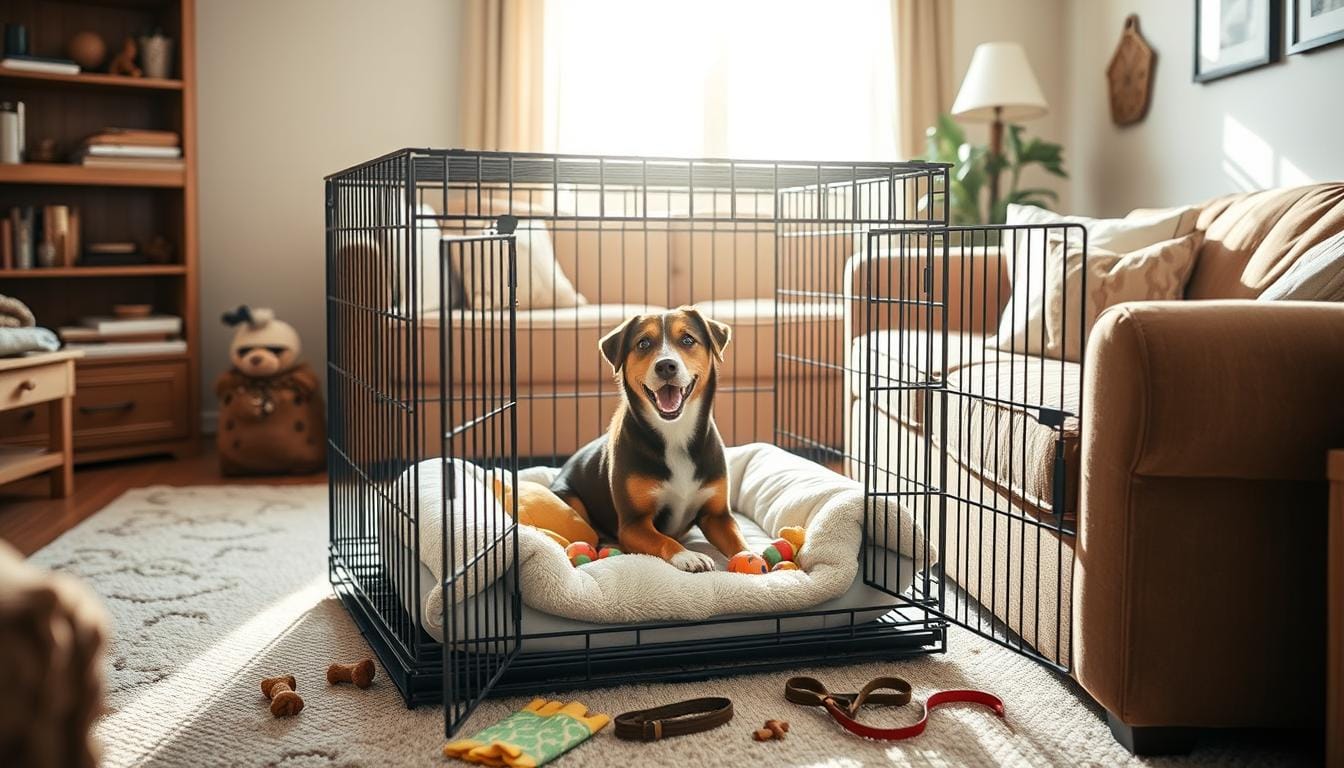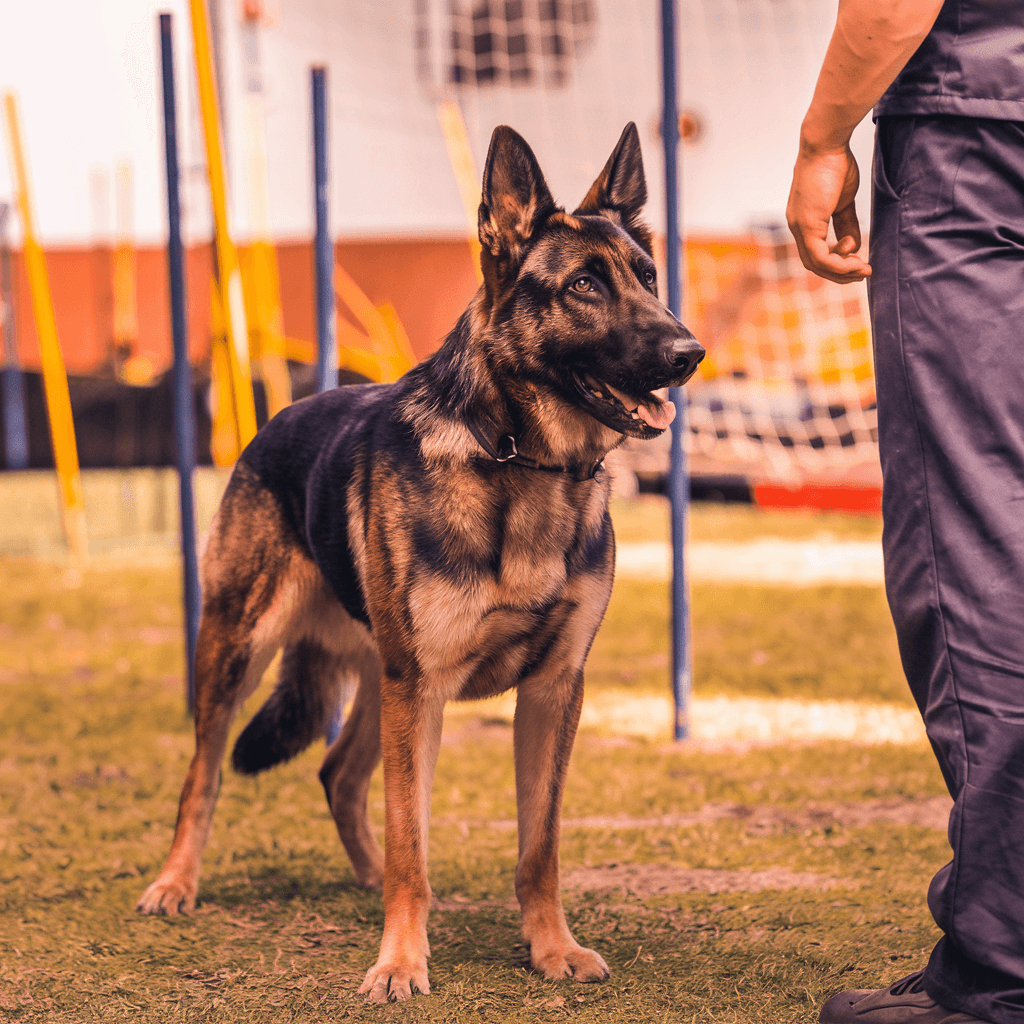What makes the Boxer special? They have a muscular build, expressive face, and endless energy. Boxers originated in 19th century Germany and are known for their loyalty and protection. Let’s dive into the world of Boxers and see why they’re so popular in the United States.
Boxers are medium-sized dogs with a strong, athletic body. Males weigh between 65 and 80 pounds, while females are a bit lighter. Their short coat is easy to groom and comes in fawn, brindle, or white. They are playful and protective, making great family pets and service dogs.
These smart dogs learn quickly with positive training. They need at least an hour of exercise every day to stay healthy. With the right care, Boxers live for 10 to 12 years, bringing joy and companionship to their families.
Key Takeaways
- Boxers originated in 19th century Germany
- They rank 10th in popularity among dog breeds in the US
- Boxers have a short coat in fawn, brindle, or white colors
- They require at least an hour of daily exercise
- Boxers are known for their loyalty and protective nature
- They have an average lifespan of 10 to 12 years
- Proper training is essential due to their intelligence and energy levels
Introduction to the Boxer Breed
The Boxer breed has won the hearts of many dog lovers around the world. We’ll explore their unique boxer characteristics. Let’s dive into the world of these loyal friends and learn about their origins and popularity.
Overview of Boxer Characteristics
Boxers are medium-sized dogs with a muscular build and expressive faces. Males are 22-25 inches tall, and females are 21-24 inches. They weigh between 55-70 pounds for males and 55-60 pounds for females. These energetic dogs live for 10-12 years.
Brief History and Origin
The boxer history goes back to 19th century Germany. They come from extinct breeds like the Bullenbeisser and Old English Bulldog. Originally used for hunting and fighting, Boxers became beloved family pets. Their name might come from their play and defense moves, like a boxer’s stance.
Popularity and Recognition
The American Kennel Club recognized Boxers in 1904. Their popularity grew in the 1930s and has stayed high since. Today, Boxers are the 11th most popular dog breed in the United States.
| Year | AKC Popularity Ranking |
|---|---|
| 2013 | 7th |
| Recent | 11th |
Boxers are loved for their playful nature, intelligence, and loyalty. They are great as working dogs and loving companions. This makes them a favorite among Americans.
Physical Traits of Boxers
Boxers have a unique look that makes them stand out. Their square heads, wrinkled foreheads, and slightly undershot jaws are quite charming. Males are usually taller and heavier than females.

Let’s take a closer look at the boxer size differences between males and females:
| Gender | Height (inches) | Weight (pounds) |
|---|---|---|
| Male | 23-25 | 65-80 |
| Female | 21-23 | 50-65 |
The boxer coat is short and smooth, needing little grooming. It comes in fawn, brindle, and white colors. Some have a black mask or white markings, making them even more appealing. Their broad chest, strong back, and curled tail show off their muscular build.
Ear cropping and tail docking are less common now. We think these natural features add to their charm. With their striking appearance and medium size, Boxers are great for active families.
The Boxer’s Temperament and Personality
Boxers are known for their unique boxer temperament, combining playfulness with loyalty. These dogs have a vibrant boxer personality that makes them stand out. Let’s explore the key aspects of their character.
Energy Levels and Playfulness
Boxers are energetic and playful companions. They love being part of family activities. Their silly antics often make their owners smile.
Boxers need plenty of exercise and mental stimulation to stay happy and healthy.
Loyalty and Protective Instincts
The boxer temperament includes strong loyalty to their family. They make excellent watchdogs and guardians. While not typically aggressive, boxers can be protective when they sense a threat.
Their affectionate nature extends to children, but supervision is necessary due to their size and enthusiasm.
Intelligence and Trainability
Boxer intelligence shines through in their ability to learn quickly. They excel in obedience training and agility work. However, their stubborn streak can sometimes pose a challenge.
Early training is crucial to manage their exuberant nature and prevent difficult habits from forming.
| Trait | Description | Percentage |
|---|---|---|
| European Boxer Ownership | Participants owning European Boxers | 57% |
| Temperament Influence | Owners believing breeding environment affects temperament | 71% |
| Laid-back Nature | European Boxer owners finding them relaxed | 100% |
While boxers are wonderful companions, they’re not suitable for everyone. Their high energy levels and need for attention make them less ideal for elderly individuals living alone or young couples in apartments. Proper care, training, and understanding of the boxer temperament are essential for a harmonious relationship with these lovable dogs.
Boxer Care and Maintenance
Proper boxer care is key to keeping these dogs healthy and happy. Boxers need a balanced diet that matches their age and activity level. Adult boxers should eat twice a day, while puppies might need three to four meals.
It’s important to control portions to avoid obesity, a common problem in this breed. Boxer nutrition should include high-quality dog food rich in protein and omega-3 fatty acids. These nutrients are good for their skin, coat, kidneys, and heart.

Boxers need 30 minutes to two hours of daily activity. They should be leash-trained because of their strong prey drive. Games and training sessions provide mental stimulation, keeping them engaged and well-behaved.
“A tired boxer is a happy boxer. Regular exercise and mental stimulation are key to maintaining their health and happiness.”
Grooming needs for boxers are relatively low. Their short coat sheds moderately and may need monthly baths. Weekly brushing keeps their coat healthy. Remember to take care of their dental health and ears to prevent infections.
| Boxer Care Aspect | Frequency | Notes |
|---|---|---|
| Feeding (Adult) | Twice daily | Portion control important |
| Exercise | 30 min – 2 hours daily | Includes walks, play, training |
| Grooming | Weekly brushing, monthly baths | Short coat, moderate shedding |
| Ear Cleaning | Twice monthly | Prevents infections |
| Dental Care | Regular brushing, annual checkups | Crucial for overall health |
Exercise Requirements for Boxers
Boxers are full of energy and need lots of physical activity. This keeps them healthy and happy. We’ll look at their exercise needs and share fun activities to keep them fit and mentally sharp.
Daily Activity Needs
Adult Boxers need about 90 minutes of exercise each day. This can be two 45-minute walks. Puppies start with 5 minutes a day and grow to more as they get older.
A 3-month-old puppy can handle 15 minutes of walks. By 10 months, they can do up to 50 minutes a day.
Suitable Exercises and Activities
Boxers love different activities that keep them fit and smart. Here are some great ones:
- Brisk walks or jogs
- Playing fetch in the backyard
- Agility training
- Swimming (with proper precautions)
- Hiking on suitable trails
Mental Stimulation Importance
Mental stimulation is key for Boxers to avoid boredom and bad behavior. Puzzle toys, training, and games are great for their minds. Mixing physical and mental activities is best for your Boxer.
| Age | Exercise Duration | Activity Type |
|---|---|---|
| 3 months | 15 minutes | Leashed walks |
| 6 months | 30 minutes | Walks, short fetch sessions |
| 10 months | 50 minutes | Walks, fetch, beginner agility |
| 12+ months | 60-90 minutes | Varied activities, full exercise routine |
Adjust your Boxer’s exercise as they age. Always check with your vet before starting new activities.
Training Your Boxer
Training a Boxer is a rewarding journey that starts early. We start when our Boxer pups are just three weeks old. These smart dogs are perfect for obedience training, making them great friends. With the right guidance, their trust, agility, and strength will show.
Socialization is key for Boxers. We introduce them to people, pets, and places from the start. This makes them well-adjusted and comfortable in various settings. Positive reinforcement, like praise and treats, helps them learn good behavior.
We teach basic commands like ‘Sit,’ ‘Stay,’ and ‘Come’ early on. By six months, most Boxer pups learn these. As they get older, we teach them more advanced skills to keep them safe and versatile.
“Boxers are sensitive souls. They thrive on interaction and consistent training. Regular exercise is crucial to manage their boundless energy.”
We also include AKC sports and activities in their training. This keeps their minds sharp and shows off their spirit. Remember, Boxers don’t do well in extreme weather, so we train outdoors carefully.
| Training Goal | Age | Focus |
|---|---|---|
| Socialization | 3-16 weeks | Exposure to new experiences |
| Basic Obedience | 8-24 weeks | Sit, Stay, Come commands |
| Grooming | 3-6 months | Coat maintenance, drool cleaning |
| Advanced Commands | 6-12 months | Stay, Come for escape prevention |
| AKC Sports | 1 year+ | Agility, tracking, obedience trials |
Boxer Health Concerns and Lifespan
Boxers face many health challenges. We’ll look at common health issues, how to prevent them, and their average lifespan.
Common Health Issues
Boxers often get sick. A study of 3,219 Boxers found that 73.97% had at least one health problem. The most common issues are:
- Ear infections (7.15%)
- Gum masses (5.84%)
- Eye ulcers (5.00%)
- Dental disease (4.63%)
Skin problems are the most common, at 17.74%. Then come neoplasia (14.20%) and ear disorders (10.41%). Hip dysplasia is also common because of their active nature.
Preventive Care Measures
To keep your Boxer healthy, follow these steps:
- Regular vet check-ups
- Balanced diet
- Proper exercise
- Vigilant skin checks for lumps
- Ear cleaning
- Dental hygiene
These steps can help find problems early and improve your Boxer’s life.
Average Lifespan Expectations
The study found that Boxers live an average of 10.46 years. They can live from 2.76 to 18.00 years. Common reasons for death include:
| Cause | Percentage |
|---|---|
| Unrecorded cause | 21.10% |
| Neoplasia | 12.43% |
| Brain disorders | 9.54% |
With the right care and attention to health concerns, Boxers can live long, happy lives.
Boxer Grooming and Coat Care
Boxers are known for their sleek, short coats in various colors. We’ll explore grooming, coat colors, and shedding to help you keep your furry friend looking their best.
Coat Colors and Patterns
Boxer coat colors range from fawn to brindle, with white markings. These athletic dogs have a single, smooth coat that’s easy to maintain. Their short fur showcases their muscular build, making them stand out in the crowd.
Grooming Needs
Boxer grooming is simple due to their short coat. Weekly brushing with a soft-bristle brush or rubber curry keeps their fur shiny and healthy. Bathing once a month or as needed is sufficient, as over-bathing can strip their coat of natural oils.
Essential grooming tools for Boxers include:
- Slicker brush for removing loose hair
- Nail trimmers for regular paw maintenance
- Thinning shears for touch-ups
- De-shedding tools for shedding seasons
Shedding Tendencies
Boxer shedding occurs year-round, but it’s manageable with regular grooming. During seasonal changes, shedding may increase. Consistent brushing helps control loose fur and keeps your home cleaner.
| Breed | Height (inches) | Coat Type | Grooming Frequency |
|---|---|---|---|
| Boxer | 21.5 – 25 | Short/Smooth | Weekly |
| Bullmastiff | 24 – 27 | Short/Smooth | Weekly |
| Cane Corso | 23.5 – 27.5 | Short/Smooth | Weekly |
Remember, regular grooming not only keeps your Boxer looking great but also strengthens your bond. With minimal effort, you can maintain your Boxer’s coat in top condition. This ensures they always look their energetic and protective best.
Conclusion
Boxer ownership brings joy and companionship to many families in the United States. These dogs are full of energy and love. They have won the hearts of many with their playful nature and loyalty.
Boxers are great family dogs, offering both protection and love. They need regular exercise, proper training, and consistent care. Their intelligence and trainability make them fit well in different homes. Their protective instincts keep their loved ones safe.
Even with some health concerns, Boxers can live long, healthy lives with the right care. They make wonderful loyal companions.
In conclusion, Boxers are a special breed. They combine strength, gentleness, and devotion. For those willing to care for them, Boxers offer endless love and unforgettable moments.
Whether you’re thinking about getting a Boxer or already have one, we hope this guide has helped you appreciate this amazing breed more.
















